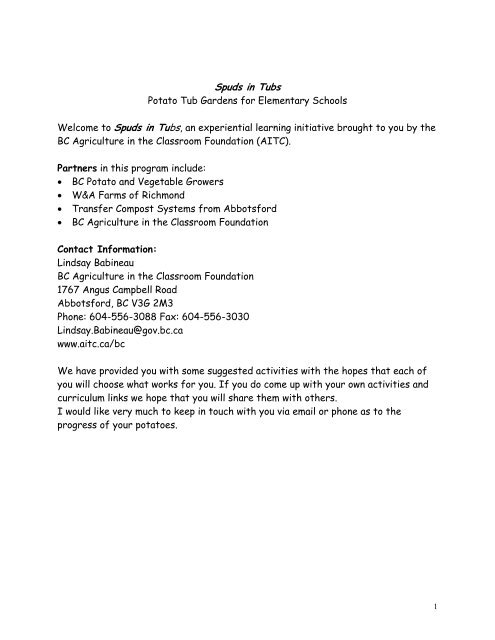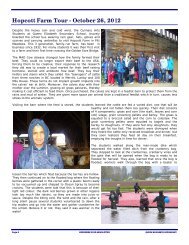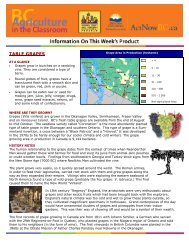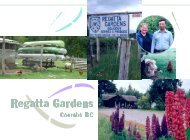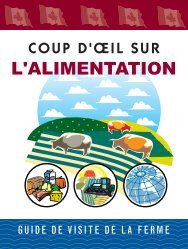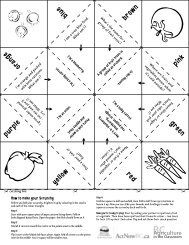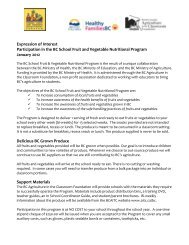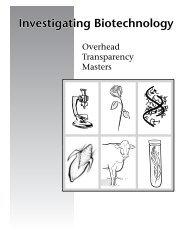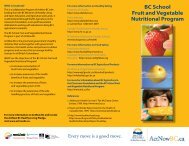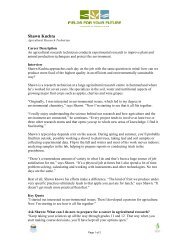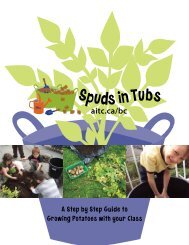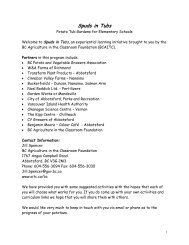Spuds in Tubs - agriculture in the classroom...
Spuds in Tubs - agriculture in the classroom...
Spuds in Tubs - agriculture in the classroom...
You also want an ePaper? Increase the reach of your titles
YUMPU automatically turns print PDFs into web optimized ePapers that Google loves.
<strong>Spuds</strong> <strong>in</strong> <strong>Tubs</strong><br />
Potato Tub Gardens for Elementary Schools<br />
Welcome to <strong>Spuds</strong> <strong>in</strong> <strong>Tubs</strong>, an experiential learn<strong>in</strong>g <strong>in</strong>itiative brought to you by <strong>the</strong><br />
BC Agriculture <strong>in</strong> <strong>the</strong> Classroom Foundation (AITC).<br />
Partners <strong>in</strong> this program <strong>in</strong>clude:<br />
• BC Potato and Vegetable Growers<br />
• W&A Farms of Richmond<br />
• Transfer Compost Systems from Abbotsford<br />
• BC Agriculture <strong>in</strong> <strong>the</strong> Classroom Foundation<br />
Contact Information:<br />
L<strong>in</strong>dsay Bab<strong>in</strong>eau<br />
BC Agriculture <strong>in</strong> <strong>the</strong> Classroom Foundation<br />
1767 Angus Campbell Road<br />
Abbotsford, BC V3G 2M3<br />
Phone: 604-556-3088 Fax: 604-556-3030<br />
L<strong>in</strong>dsay.Bab<strong>in</strong>eau@gov.bc.ca<br />
www.aitc.ca/bc<br />
We have provided you with some suggested activities with <strong>the</strong> hopes that each of<br />
you will choose what works for you. If you do come up with your own activities and<br />
curriculum l<strong>in</strong>ks we hope that you will share <strong>the</strong>m with o<strong>the</strong>rs.<br />
I would like very much to keep <strong>in</strong> touch with you via email or phone as to <strong>the</strong><br />
progress of your potatoes.<br />
1
British Columbia Science Curriculum<br />
Learn<strong>in</strong>g Outcomes for Grades K – 6<br />
“All Canadian students. . . should have opportunities to develop scientific literacy.<br />
Scientific literacy is an evolv<strong>in</strong>g comb<strong>in</strong>ation of <strong>the</strong> science-related attitudes,<br />
skills, and knowledge students need to:<br />
develop <strong>in</strong>quiry, problem-solv<strong>in</strong>g, and decision-mak<strong>in</strong>g abilities as citizens<br />
become lifelong learners ma<strong>in</strong>ta<strong>in</strong> a sense of wonder about <strong>the</strong> world around <strong>the</strong>m”.<br />
(From <strong>the</strong> Science K to 7 Integrated Resource Package 2005, BC M<strong>in</strong>istry of<br />
Education, page 11)<br />
K<strong>in</strong>dergarten<br />
- describe features of local plants (e.g., colour, shape, size, texture)<br />
- compare local plants<br />
- demonstrate <strong>the</strong> ability to observe <strong>the</strong>ir surround<strong>in</strong>gs<br />
- describe features of <strong>the</strong>ir immediate environment<br />
- use <strong>the</strong> five senses to make observations<br />
- share with o<strong>the</strong>rs <strong>in</strong>formation obta<strong>in</strong>ed by observ<strong>in</strong>g<br />
Grade 1<br />
- classify liv<strong>in</strong>g and non-liv<strong>in</strong>g th<strong>in</strong>gs<br />
- describe <strong>the</strong> basic needs of local plants (e.g., food, water, light)<br />
- describe how <strong>the</strong> basic needs of plants are met <strong>in</strong> <strong>the</strong>ir environment<br />
- describe changes that occur <strong>in</strong> daily and seasonal cycles and <strong>the</strong>ir effects on<br />
liv<strong>in</strong>g th<strong>in</strong>gs<br />
- communicate <strong>the</strong>ir observations, experiences, and th<strong>in</strong>k<strong>in</strong>g <strong>in</strong> a variety of ways<br />
(e.g., verbally, pictorially, graphically)<br />
Grade 2<br />
- describe physical properties of air, water, and soil<br />
- dist<strong>in</strong>guish ways <strong>in</strong> which air, water, and soil <strong>in</strong>teract<br />
- expla<strong>in</strong> why air, water, and soil are important for liv<strong>in</strong>g th<strong>in</strong>gs<br />
- use <strong>the</strong>ir senses to <strong>in</strong>terpret observations<br />
- <strong>in</strong>fer <strong>the</strong> probable outcome of an event or behaviour based on observations<br />
2
Grade 3<br />
- compare familiar plants accord<strong>in</strong>g to similarities and differences <strong>in</strong> appearance<br />
and life cycles<br />
- ask questions that foster <strong>in</strong>vestigations and explorations relevant to <strong>the</strong> content<br />
- measure objects and events<br />
Grade 4<br />
- compare <strong>the</strong> structures of local plants <strong>in</strong> different habitats<br />
- analyse impacts of wea<strong>the</strong>r on liv<strong>in</strong>g th<strong>in</strong>gs<br />
- make predictions, supported by reasons and relevant to <strong>the</strong> content<br />
- use data from <strong>in</strong>vestigations to recognize patterns and relationships and reach<br />
conclusions<br />
Grade 5<br />
- analyse how BC’s liv<strong>in</strong>g resources are used<br />
- identify methods of harvest<strong>in</strong>g and process<strong>in</strong>g BC’s resources<br />
- describe potential environmental impacts of us<strong>in</strong>g BC’s liv<strong>in</strong>g resources<br />
- identify variables that can be changed <strong>in</strong> an experiment<br />
- evaluate <strong>the</strong> fairness of a given experiment<br />
- describe <strong>the</strong> steps <strong>in</strong> design<strong>in</strong>g an experiment<br />
Grade 6<br />
- demonstrate <strong>the</strong> appropriate use of tools to exam<strong>in</strong>e liv<strong>in</strong>g th<strong>in</strong>gs that cannot be<br />
seen with <strong>the</strong> naked eye<br />
- analyse how different organisms adapt to <strong>the</strong>ir environments<br />
- manipulate and control a number of variables <strong>in</strong> an experiment<br />
- apply solutions to a technical problem (e.g., malfunction<strong>in</strong>g electrical circuit)<br />
3
<strong>Spuds</strong> <strong>in</strong> <strong>Tubs</strong><br />
Objective<br />
As part of science, social studies and now healthy liv<strong>in</strong>g it has been brought to our<br />
attention that many schools would like to grow food at <strong>the</strong> school but f<strong>in</strong>d it<br />
difficult to work with <strong>in</strong> ground school gardens. As a solution AITC has developed<br />
potato tub gardens that will allow students to grow and eat nugget potatoes with<strong>in</strong><br />
<strong>the</strong> school year.<br />
Materials provided with <strong>Spuds</strong> <strong>in</strong> <strong>Tubs</strong>:<br />
5 – 60 litre plastic tubs with rope handles and predrilled dra<strong>in</strong>age holes<br />
15 – 20 litre bags of special potato grow<strong>in</strong>g compost made from spent mushroom<br />
compost, composted dairy cow manure and worm cast<strong>in</strong>gs<br />
30 plus Warba seed potatoes<br />
35 plant tags<br />
One plastic tarp<br />
One clean compost bag to be used as a class poster<br />
5 AITC rulers<br />
Grow BC map<br />
Kids and Carbs recipe brochures<br />
Procedure:<br />
Spread seed potatoes out on newspaper <strong>in</strong> <strong>the</strong> <strong>classroom</strong> to encourage sprout<strong>in</strong>g.<br />
When <strong>the</strong> seed potatoes have shoots that are about 2.5cm <strong>in</strong> length it is time to<br />
plant <strong>the</strong> potatoes.<br />
Plant<strong>in</strong>g<br />
S<strong>in</strong>ce <strong>the</strong> tubs are portable, potatoes can be planted <strong>in</strong> <strong>the</strong>ir tubs ei<strong>the</strong>r <strong>in</strong> <strong>the</strong><br />
<strong>classroom</strong> or some o<strong>the</strong>r place <strong>in</strong> <strong>the</strong> school and <strong>the</strong>n, when <strong>the</strong> new leaves are just<br />
appear<strong>in</strong>g through <strong>the</strong> soil, placed outside <strong>in</strong> a sunny well-protected area of <strong>the</strong><br />
school grounds.<br />
Remember: If you are plant<strong>in</strong>g <strong>in</strong>side <strong>the</strong>n be sure to protect <strong>the</strong> floor with <strong>the</strong><br />
tarp provided as <strong>the</strong> tubs do have dra<strong>in</strong>age holes.<br />
Empty three bags of compost <strong>in</strong>to each of <strong>the</strong> 5 tubs provided. Gently firm <strong>the</strong><br />
compost down after <strong>the</strong> addition of each bag. If <strong>the</strong>re is a bit too much <strong>the</strong>n save<br />
that compost for future garden<strong>in</strong>g projects.<br />
4
Dig 6-8 (depend<strong>in</strong>g on <strong>the</strong> number of students) evenly spaced small holes about 10<br />
cm deep and about 10cm from <strong>the</strong> edge of <strong>the</strong> tub. In <strong>the</strong> bottom of <strong>the</strong> holes<br />
place <strong>the</strong> potatoes with <strong>the</strong>ir sprouts fac<strong>in</strong>g up. Us<strong>in</strong>g pencils and <strong>the</strong> plant tags<br />
<strong>in</strong>cluded have students place <strong>the</strong>ir name beside <strong>the</strong>ir seed potato. Cover <strong>the</strong><br />
potatoes with compost be<strong>in</strong>g careful not to cover <strong>the</strong> student’s plant tags. Give<br />
<strong>the</strong>m all a good dr<strong>in</strong>k of water – about ½ a can full.<br />
Water<strong>in</strong>g<br />
Your potatoes will require occasional water<strong>in</strong>g. You can tell if <strong>the</strong> tubs are dry by<br />
ei<strong>the</strong>r feel<strong>in</strong>g <strong>the</strong> compost with your f<strong>in</strong>gers or not<strong>in</strong>g if <strong>the</strong> compost is pull<strong>in</strong>g away<br />
from <strong>the</strong> side of <strong>the</strong> tub. Wilted potatoes will slow down production.<br />
Feed<strong>in</strong>g<br />
You potato plants will not require fertilizer. The compost provided will give <strong>the</strong><br />
potatoes all of <strong>the</strong> nutrients <strong>the</strong>y require. The potato plants will grow to become<br />
tall green and bushy. Sometime <strong>in</strong> May <strong>the</strong>y will flower and <strong>in</strong> June when <strong>the</strong><br />
flowers have faded it will be time to harvest <strong>the</strong> potatoes.<br />
Harvest<br />
Have students carefully dig up <strong>the</strong>ir potato plants try<strong>in</strong>g to keep <strong>the</strong>ir potatoes<br />
attached (<strong>the</strong> nugget potatoes are actually a modified stem).<br />
See if students can f<strong>in</strong>d <strong>the</strong>ir orig<strong>in</strong>al seed potato. What does it look like now<br />
Have students count <strong>the</strong> number of nugget potatoes from each of <strong>the</strong>ir plants and<br />
compare to o<strong>the</strong>r tubs. If possible weigh <strong>the</strong> total harvest. Imag<strong>in</strong>e what can be<br />
grown <strong>in</strong> an entire field!<br />
Once <strong>the</strong> potatoes are harvested <strong>the</strong> grow<strong>in</strong>g compost can be added to exist<strong>in</strong>g<br />
shrub beds around <strong>the</strong> school and <strong>the</strong> tubs washed and put away until next spr<strong>in</strong>g.<br />
Eat<strong>in</strong>g<br />
Wash carefully and <strong>the</strong>n steam your potatoes <strong>in</strong> <strong>the</strong> school kitchen. Add a little<br />
fresh butter and serve <strong>the</strong>m to your students, parents or o<strong>the</strong>r teachers. Enjoy<br />
<strong>the</strong> feel<strong>in</strong>g of grow<strong>in</strong>g your own food and enjoy <strong>the</strong> taste of really fresh potatoes!<br />
5
Activities – Before Plant<strong>in</strong>g<br />
• Record Number and colour of seed potatoes<br />
• Record total weight of seed potatoes<br />
• Number of days to full 2 cm sprouts<br />
• Number and colour of sprouts per potato/overall for <strong>the</strong> class<br />
• Observe and record any changes <strong>in</strong> <strong>the</strong> seed potato sk<strong>in</strong> as <strong>the</strong> sprout grows<br />
• Cut and make observations of extra seed potatoes or any that do not sprout<br />
Compost<br />
1) From <strong>the</strong> empty compost bag provided make up a list of 10 vocabulary words and<br />
f<strong>in</strong>d def<strong>in</strong>itions ie: nutrients, compost, pH, organic etc.<br />
2) Open one bag of compost. Record observations about <strong>the</strong> colour, texture, and<br />
smell of <strong>the</strong> compost.<br />
What is <strong>the</strong> volume of material found <strong>in</strong> <strong>the</strong> compost bag<br />
How many bags will it take to fill one tub<br />
Grow<strong>in</strong>g<br />
Observations<br />
• Record and graph <strong>the</strong> height of <strong>the</strong> plants to <strong>the</strong> number of days<br />
• Count <strong>the</strong> number of flowers. Make observations – colour, number of petals,<br />
colour of stamens etc. Draw flowers and label <strong>the</strong> parts.<br />
• Observe <strong>the</strong> leaves – colour, shape, ve<strong>in</strong>s etc. Do leaf rubb<strong>in</strong>gs<br />
• Record number of sunny days, sunrise and sunset, watch how <strong>the</strong> days are<br />
gett<strong>in</strong>g longer, average temperature, frost etc.<br />
• Record <strong>the</strong> number of days that your plants are <strong>in</strong> <strong>the</strong> tubs.<br />
Extension<br />
• F<strong>in</strong>d out more about Warba potatoes and o<strong>the</strong>r potato varieties<br />
• Us<strong>in</strong>g <strong>the</strong> map of BC f<strong>in</strong>d out where potatoes are grown<br />
• Try to sprout nugget potatoes from <strong>the</strong> grocery store<br />
• Research <strong>the</strong> value of potatoes to a healthy diet<br />
• Share recipes<br />
6
Notes:<br />
7


